A New Discovery!
This is not technically a ‘new discovery’ because although I already knew the names of these people, I never knew that anyone had survived—so THAT is the exciting new discovery! All these years, despite all my efforts to find anyone who survived from this Czechoslovakian family, all my efforts failed. But no longer!
Here’s how it happened, and here’s what I learned:
I learned that one person survived,—thanks to my tech-savvy jazz musician educator friend, Anton Schwartz, who urged me to create EYES FROM THE ASHES Facebook page. He created it for me and said to choose a photo for the page, so I chose one of my favorites, depicting Artur and Grete Huppert family with their only child, Peterle.
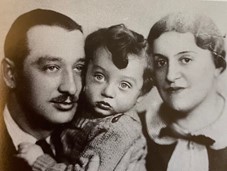
Out of 2400 photos, I chose this one, and to my joy (and surprise), I received this message: “This is my great uncle, Artur Huppert and his family. My grandfather was Ferdinand Huppert.” It was signed by Pégy, a woman in the Czech Republic.
The Huppert Family—both because of their many beautiful photographs and their distinctive, probing eyes, has always felt special to me, so much so that I featured them in my book, The Last Album: Eyes from the Ashes of Auschwitz-Birkenau. However, until Pégy’s brief note, I had believed every member of this Czechoslovakian based family was killed. Now I know that one person survived!
I had long known the names of this family, and I even knew specifics of their deaths. From a book detailing the fate of Czechoslovakian Jews, I learned that Artur, Grete and Peterle Huppert were deported to Baranawicz concentration camp on Transport #AAy on July 28, 1942. On this transport of 900 Jews, which included Artur, Grete and Peterle, only 56 souls survived. For decades, I wished that somehow they were among the 56, even though I knew that my hope was unrealistic.
The whole Czecholoakian branch of this Huppert Family had been killed—except Ferdinand, whose wedding picture you see below, together with Artur’s. Pégy affirmed that her grandfather was, indeed, the only survivor of this Czechoslovakian-based family. [Note: there is also a Polish branch of this family, a distant cousin, where (at least) one member survived, but these two branches were not close, neither before, nor after, the war].
Here’s what I knew, and here are a few photos from my book:
The Huppert Family lived comfortably in pre-war Czechoslovakia. In my book, The Last Album: Eyes from the Ashes of Auschwitz-Birkenau, we see them in a variety of pre-war and early war photos. Here is the Huppert Family, including the parents, Rozinka (Rose) and Jusekl (Joseph), with their sons and daughters.
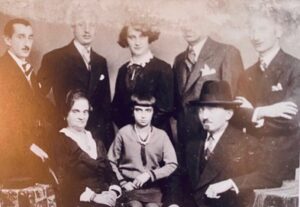
Thanks to Pégy, I now know the names of each one, including the young child in the front (whom I had always assumed was a grandchild, but now know to be Frieda, the late-in-life child of Rozinka and Jusekl, born in 1920 (As you see, her siblings were significantly older).
From left to right, top row: Adolf Huppert (b.1905 d.??), Artur Huppert (b.7/9/09 d.7/28/42), Mitzie Huppertova (this is the feminized form of Huppert—b.6/29/06 d.3/12/42), Markus Huppert (b.1912 d.1942), Ferdinand Huppert (b.6/12/13 d.11/3/81). Bottom row: Rozinka (mother) d.1943, Frieda (b.1920 d.1943, Jusekl (d. 1940).
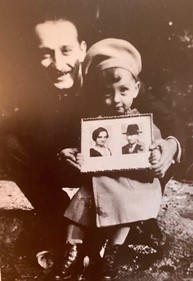
This photo has become the signature photo of my traveling exhibition. I have always seen it as a visual communication in which Artur has ingeniously found a way to create a 3-generation family portrait—although separated geographically from his parents who lived in Tesin. Note the framed images that little Peterle holds are copied directly from the family portrait above. Thanks to Pégy, I now know that, when deported to Auschwitz, it was Rozinka, who carried all the photos of her beloved children and grandchildren with her. By 1943, when the final deportation from Bendzin-Sosnowiec took place, her husband, Jusekl, had already died in the ghetto in 1940.
More pre-war photos of the Huppert Family from my book:
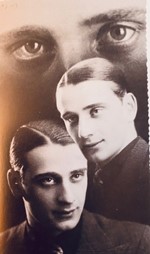
Before becoming a father, Artur would often have dramatic and stunning professional studio photos taken—one of the most unique being this triple exposure of Eyes.
Here are the wedding portraits of Artur and Grete Huppert (on left) on January 9, 1938 in Opava (their baby, Peterle, was born exactly 9 months later October ’38), and on the right is the wedding of Ferdinand and Hilde Huppert.
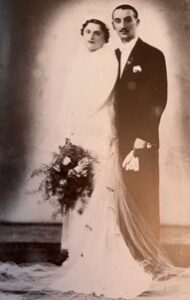
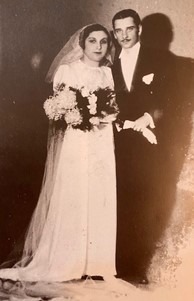
Hilde (known as ‘Hinda’) and Ferdinand—like brother Artur and sister-in-law Grete—also had one child, a little boy Harry.
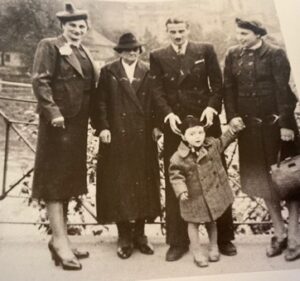
From L to R: Sister Mitzie Huppert, Mother Rozinka (Rosa), Brother Ferdinand, and his wife, Hilde. Harry stands in front.
Most of the photos in the Huppert section of my book show Artur, Grete and their child Peterle. But before Artur became a father, there are a number of studio portraits of him, (like the Eyes photo, above), where he is the subject of many stylized posings. However after he became a father, the focus of all his photos became his little Peterle.
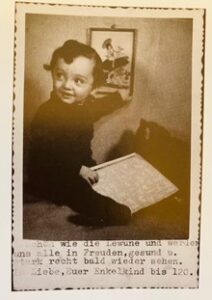
Here, the translation reads: “As pretty as the moon and we will all see each other again very soon, in freedom, in health, when all this is behind us. Love, your grandchild, until 120 (years),” Olmutz February 1940
With Pégy’s new information, I learned that, of all the Czechoslovakian Huppert, only Ferdinand survived.
Ferdinand was born June 12, 1913, and lived with his Huppert family in the Cesky Tesin region of Czechoslovakia. He completed high school and studied 7 subjects. When he married Hilde Weiss, born in 1919 (no relation, as far as I can discern…yet), they had one child, Harry who was born in 1937, the year before his first cousin, Peterle (Artur’s and Grete’s only child—featured in the photos above). Fashion seemed to be the family business: Ferdinand worked as a hatter and shoemaker, and his father, Jusekl (Joseph), was a tailor.
Artur, his wife and child were deported to Terezin in 1942, and then transported to Baraovich, where they all died. Parents Rozinka and Jusekl, together with their two daughters, Mitzie and Frieda, were in the Bedzin Ghetto, where Jusekl (Joseph) died in 1940, both girls with their mother died at Auschwitz-Birknenau.
The remaining brothers, Ferdinand, Adolf and Markus, were deported to Nisko and Sanem near the start of the war, on October 26, 1939. Ferdinand then crossed the German-Soviet border on November 2, 1939 and reached Lemberg/Lvov (now Lviv, Ukraine), where he worked as a day laborer. He was arrested, with Markus and Adolf, by the NKVD on June 28, 1940. Based on various sources—including the records of the NKVD**— we learn that Ferdinand was imprisoned without a sentence from July 28, 1940 until January 28, 1942, and then shortly after his release (March 2, 1942), he was taken to the Czechoslovakian military unit in Buzuluk, where he was wounded in fighting near Sokolov on March 9, 1943. Until 1945, in the rank of company office, he worked as a driver in the First Czechoslovak Independent Tank Brigade. His brothers, Adolf and Markus, were also released from the gulag and went to Buzuluk, but both died before being recruited into Ferdinand’s Czechoslovak military unit.
**[Note: NKVD, initials of the “People’s Commissariat for Internal Affairs”, established in 1917, was the Interior Ministry of Soviet Federative Socialist Republic. It functioned as the secret police and was the forerunner of the KGB. Under Stalin and after the Bolshevik Revolution, it expanded its role as Stalin’s secret police.]
Postwar, when Ferdinand returned to his family’s home of Cesky Tesin in 1945, to search for relatives—as virtually every survivor did—he found that no one had survived. Alone, and determined to start a new life, he moved to Jesenik, where he ultimately met his second wife, Margita, whom he married in 1949. Together they raised the son from her first marriage, Ladislav (born 1946) and then had two children together, a little boy named Joseph and a little girl named Libuse.
It is significant to note that no one except Ferdinand knew that Joseph was being named after his own father. Pégy is the daughter of Ferdinand’s daughter.
Post war, Ferdinand operated a small passenger car transport company, but after the Communists came to power in 1948, he was forced to close his business. Subsequently, he worked in the Jesenik Hotel, as the front desk receptionist, and briefly, with his wife, he also ran a buffet at the local cinema.
His death in 1981 was peaceful. Ferdinand died in his sleep, apparently of heart failure, caused by shrapnel still circulating in the his bloodstream after his war injury. Time limitations do not permit me to wait as I am still trying to research more about how the Huppert Family lived, pre-war, instead of how they died. Pégy is trying to learn more about her grandfather’s life from her mother and uncle. I will share more with you, when I learn more from Pégy.
Posted in From Ann | No Comments »